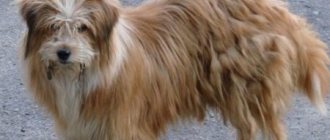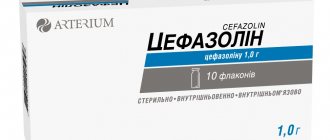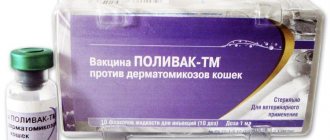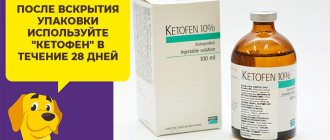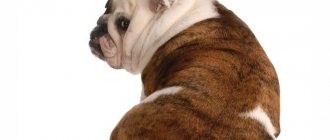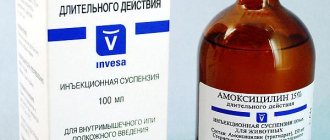The Multkan 8 vaccine consists of 2 components:
- lyophilisate containing strains of canine distemper virus, canine adenovirus type 2, parvovirus and canine coronavirus
- a solvent containing strains of Leptospira serogroups Canicola and Icterohemorrhagia and rabies antigen
Lyophilisate Multikana-8 is a dry, homogeneous, finely porous mass of yellow-pink color.
The solvent is a homogeneous pink suspension with sediment at the bottom of the bottle (adjuvant), which, when shaken, easily breaks into a homogeneous suspension. The lyophilized and liquid components of the vaccine are produced in volumes of 1 and 2 ml, respectively, in bottles or ampoules with a capacity of 3-10 ml.
The Multikana-8 bottle contains one dose of each vaccine component. Other packaging of Multkan is allowed, agreed upon in accordance with the established procedure. The box with the drug contains instructions for use. The liquid component is a lyophilized solvent.
Biological features of the drug
Depending on the specific indicator, the medicine contains different active substances:
- Multikan-4 – canine plague, adenovirus, coronovirus and parvovirus enteritis;
- Multikan-6 - in addition to the above diseases, prevents infection with leptospirosis;
- Multikan-8 - in addition to the above diseases, prevents rabies infection.
The fourth is considered the most ineffective. Dogs develop immunity 2-3 weeks after the procedure. The validity period depends on the age of the animal. For young pets (up to 2 years) – 6-8 months, for adults – 12-15 months.
Multikan is available in 2 bottles : the first contains 1 ml of dry substance with active ingredients (pinkish-yellow mixture); the second is available in several volumes (2, 3, 10 ml), contains a homogeneous suspension (material for diluting the dry component).
INDICATIONS FOR USE
According to the instructions, Multikan-8 is intended for immunizing dogs against:
- plague
- adenoviral infections
- parvovirus enteritis
- coronavirus enteritis
- leptospirosis
- rabies
Plague virus.
Modified live virus (MLV) vaccines are most effective in protecting dogs against distemper. Inactivated whole virus vaccines are not effective. Vaccination with Multican-8 in puppies usually continues until 16 weeks of age. Dogs over 12 weeks old when presented for initial vaccinations should receive at least 2 vaccinations 2 to 3 weeks apart.
Infectious hepatitis.
Vaccination against adenovirus infection in dogs, the cause of canine hepatitis (ICH) infection, is usually given in combination with that for distemper and other diseases, starting at 6-8 weeks. Attenuated (MLV) adenovirus vaccines are commonly used due to their ability to induce a superior immune response. Therefore, vaccination against adenovirus is usually combined with canine distemper virus; Multikan-8 is excellent for this purpose.
Infectious tracheobronchitis in dogs.
Infectious tracheobronchitis, or kennel cough, is a complex clinical infection caused by a number of respiratory pathogens that can infect dogs individually or in combination. The Multikan-8 vaccine is intended for immunization of dogs against adenovirus type 2.
Canine parvovirus
- the most dangerous viral disease for puppies. Canine parvovirus 2 (CPV-2) vaccines are available as inactivated or attenuated products. Multikan-8 is an effective solution for the prevention of parvovirus in dogs.
Canine coronavirus.
Most vaccines licensed for canine coronavirus are inactivated canine coronavirus strains. Multikan 8 has a strain against canine coronavirus.
Leptospirosis. The Multikan-8 vaccine includes an inactivated anti-leptospirosis component. However, the lack of global and regional data on the incidence of leptospirosis in dogs makes it much more difficult to decide whether vaccination is necessary and which vaccines should be used.
MULTIKAN-8 Vaccine for dogs, 2 bottles = 1 dose
DESCRIPTION
Multikan-8 is a vaccine against distemper, adenoviral infections, parvovirus and coronavirus enteritis, leptospirosis and rabies in dogs. In appearance, the lyophilized component is a dry, homogeneous, finely porous mass of yellow-pink color. The liquid component is a transparent or slightly opalescent liquid, the color of which can vary from light yellow to pink with a gray-white sediment at the bottom of the bottle of varying intensity, which breaks down into a homogeneous suspension when shaken.
COMPOUND
The dry component - lyophilized mass - is made from attenuated industrial strains of canine distemper virus, canine adenovirus type 2, parvovirus and canine coronavirus with a drying medium.
The liquid component - suspension for injection - is made from industrial inactivated strains of Leptospira serogroups Icterohaemorrhagiae, Canicola and Grippotyphosa, industrial inactivated strain of rabies virus with an adjuvant amounting to no more than 10% of the volume of the vaccine.
BIOLOGICAL PROPERTIES
The Multikan-8 vaccine causes the formation of an immune response in dogs to plague, adenovirus infections, parvovirus, coronavirus enteritis, leptospirosis and rabies 2-3 weeks after immunization, lasting 6-8 months in young animals, 12-15 months in adults.
One immunizing dose of the vaccine contains at least: canine distemper virus - 103.5 TCD50, canine adenovirus type 2 - 103.0 TCD50, canine parvovirus - 103.0 GAU, canine coronavirus - 103.0 TCD50, rabies virus - 1 IU, leptospira serogroups Icterohaemorrhagiae, Canicola, Grippotyphosa – 3x108 microbial cells.
The vaccine is harmless and areactogenic and has no medicinal properties.
DOSAGE AND APPLICATION
The Multikan-8 vaccine is intended for the prevention of distemper, adenovirus infections, parvovirus and coronavirus enteritis, leptospirosis and rabies in dogs.
Multikan-8 is administered to puppies twice (at 8-10 weeks of age and after 21-28 days) intramuscularly in the thigh area in a dose of 2.0 ml.
Revaccination of puppies is carried out at the age of 10-12 months.
Dogs of small and decorative breeds are vaccinated at a dose of 1 ml.
Adult dogs are vaccinated once a year at a dose of 2 ml.
Before use, the vaccine is heated to a temperature of 36-38°C; during use, the vials with the vaccine are thoroughly shaken until a homogeneous suspension is formed.
Before use, the lyophilized vaccine component is dissolved in 2 ml of the supplied solvent (liquid component). When using, prevent precipitation of vaccine components. If there is a slight, non-breakable sediment, the vaccine is pipetted into the vial 3-5 times using a syringe until a uniform homogeneous suspension is obtained.
Vaccination is carried out in compliance with the rules of asepsis; only sterile materials and instruments are used for injection. A separate needle is used for each animal.
SPECIAL INSTRUCTIONS
No symptoms of plague, adenoviral infections, parvovirus and coronavirus enteritis, leptospirosis and rabies or other pathological signs were identified in case of an overdose of the vaccine.
Features of the post-vaccination reaction during primary and subsequent vaccinations have not been established.
Violations of the vaccination schedule (timing) should be avoided, as this can lead to a decrease in the effectiveness of immunoprophylaxis against distemper, adenovirus infections, parvovirus and coronavirus enteritis, leptospirosis and rabies in dogs. If the next dose of vaccine is missed, immunization should be carried out as soon as possible.
CONTRAINDICATIONS
It is prohibited to vaccinate clinically sick and/or weakened animals and dogs in the last month of pregnancy and in the first month after birth.
SIDE EFFECTS
When using the vaccine in accordance with these instructions, there are usually no side effects or complications. A quickly disappearing swelling may appear at the injection site. If some animals develop allergic reactions to the vaccine, antihistamines are used.
SHELF LIFE AND STORAGE
The shelf life of the vaccine is 18 months from the date of release, subject to storage and transportation conditions. After the expiration date, the vaccine is not suitable for use.
The vaccine is stored and transported in a dry, dark place at a temperature of 2°C to 8°C. Should be stored out of the reach of children.
PACKAGE
The dry and liquid components of the vaccine are packaged in 1.0 ml (1 dose) bottles or ampoules with a capacity of 3.0 ml. The vials are sealed with rubber stoppers reinforced with aluminum caps, the ampoules are hermetically sealed. The vials (ampoules) with the vaccine are packaged in cardboard (plastic) boxes or blisters. Each box of vaccine contains instructions for its use.
DOSE OF MULTICAN-8 AND METHOD OF ITS APPLICATION
- Before use, the lyophilized vaccine Multikan 8 is dissolved in a bottle
with a liquid component and shaken until a homogeneous suspension is obtained. - The vaccine is administered intramuscularly in the thigh area in a dose of 2 ml immediately after dissolution. Dogs of small and decorative breeds are vaccinated at a dose of 1 ml.
- Adult dogs are vaccinated once a year.
- A separate needle is used for each animal.
- Syringes and needles are sterilized by boiling for 10 minutes before use.
- The vaccine is administered to puppies at 8-10 weeks of age and again after 21-28 days. Revaccination of puppies is carried out at the age of 10-12 months.
Analogues of the drug
There are many domestic and imported preparations similar to the Multican 8 vaccine. All of them contain strains against infectious diseases - distemper, coronavirus, paraviral, adenoviral infections and rabies:
- nobivac;
- hexadog;
- eurican;
- biocan;
- Primodog;
- Vanguard.
The list of vaccines is very large, and each dog owner individually selects the option that he considers the most effective for his pet.
We invite you to discussion and look forward to your comments on the issue of dog vaccination. What did you encounter when vaccinating your dog, how did the animal react to the vaccination? We are ready to listen to any opinion and open a discussion on this issue.
Share
Leave a review
Types of Vaccines
The technologies used to produce canine vaccines have expanded significantly over the past decade. In veterinary medicine today, the number of licensed vaccines continues to grow, driven in large part by the need to protect dogs and cats from emerging pathogens, improve vaccine safety, and improve the immunogenicity of existing vaccines. However, the recent introduction of Therapeutic Biology into veterinary medicine highlights the role of new types of vaccines licensed for the treatment rather than the prevention of disease (especially cancer) in dogs and cats. Multikan-8 is a highly effective vaccine for dogs produced in Russia.
LIMITATIONS: Inactivated vaccines are generally less immunogenic and generally do not have an increased duration of immunity (immunological memory) compared to attenuated live vaccines using the same microorganism. Inactivated vaccines often contain an adjuvant designed to stimulate local inflammation and enhance the immune response to the antigen. Post-vaccination reactions associated with inactivated vaccines include injection site pain and granuloma formation, as well as angioedema.
Application procedure
Instructions for use for the Multikan-8 product indicate that the main purpose of the vaccine is the prevention of adenovirus infection, distemper, dog rabies, canine leptospirosis, coronavirus and parvovirus enteritis. Contraindications for vaccinating dogs are: sick and weakened animals, pregnant dogs in the last month, dogs in the first postpartum month.
What else does the instructions for use say about Multikan-8?
Puppies are vaccinated at approximately 8-10 weeks of age and 21-28 days later. The injection is given intramuscularly, the dose is 2 ml. Revaccination in puppies is carried out at approximately 10-12 months of age.
Vaccination of adults is carried out in a dosage of 2 ml once a year. Small and decorative breeds are also vaccinated once a year with a dosage of 1 ml. Before use, the vaccine is heated to a temperature of 36-38°C and shaken well until a homogeneous suspension is formed.
Vaccination is carried out in compliance with the rules of asepsis. Instruments and materials for injections must be sterile, or better yet, disposable.
In case of overdose, symptoms of plague, leptospirosis and rabies, coronavirus and parvovirus enteritis, and adenoviral infections were not recorded. No post-vaccination reactions were detected. This is confirmed by the instructions for use and reviews of the Multikan-8 product.
For effective immunoprophylaxis of these dangerous diseases for dogs, the timing and schedule of vaccinations must be strictly observed.
If you follow the instructions, no complications or adverse reactions should occur. A swelling may appear at the injection site, which will disappear fairly quickly.
If an animal experiences an allergic reaction to the vaccine, antihistamines should be used.
Mixing several biological products or vaccines in one syringe is not allowed. Vaccination is carried out 7 days after deworming and 14 days after treatment with preparations containing phosphorus and chlorine.
Testing the blood serum of a vaccinated animal for the presence of antibodies to Leptospira and microagglutination (PMA) is possible only after 2 months after vaccination.
Learn about essential drugs in animals
- Do puppies need to be vaccinated?
- Vaccination against rabies in cats
- Vaccination of small animals
- Kitten vaccination
- Why vaccinate dogs against rabies?
- Why do kittens need to be vaccinated?
- What kind of drug is Nobivak Triquet Trio?
- Nobivac DHPPi for dogs
- What is the first vaccination for a puppy?
- Comprehensive vaccinations for cats
- Tick vaccination for dogs
- What vaccinations are given to dogs and why?
- Why do cats need Ursofalk?
- Instructions for using serenia for animals
- Ursofalk in dogs
- Marfloxin for veterinary medicine
- Instructions for the use of serenia in dogs
- Graying in cats - Instructions
- Why is Heptor prescribed to a dog?
- Instructions for the use of lidocaine in dogs
- Heptor in cats
- Lidocaine for cats. Can cats use lidocaine?
- Heptral in dogs
- Can cats use marfloxin?
- Marfloxin for dogs (instructions for use)
- Heptral in cats (instructions for use, pharmacology
- Instructions for use of Dirofen for cats
- Instructions for using Vetom in cats
- Instructions: multifel for cats
- Use of fosprenil in cats
^Top
Instructions for use
The Multikan 4 vaccine is used according to the same requirements as the other ones. The first vaccination of puppies is allowed from the age of two months with the obligatory repetition of the procedure after a few weeks. This strengthens the action of the drug and allows the animal to form strong immunity. Re-vaccination of a young dog is carried out at the age of 8 months with a similar repeat of the procedure a few weeks later. All subsequent vaccinations of adults must be carried out annually, since Multikan provides the body with immunity for 10–12 months.
The vaccination procedure itself begins with the preparation of the drug. To do this, you need to draw the liquid part of the kit into a sterilized syringe and release it into a bottle with dry powder, then mix it thoroughly. The solution should be transparent , without sediment. When the mixture is ready, it must be well heated to the dog’s body temperature (approximately 380C). This will reduce the animal's shock during the injection. After preparation, the vaccination itself begins.
The injection can be given intramuscularly or subcutaneously. To do this, select the area of the withers or hip, depending on the breed of the dog. It is important to maintain sterility during the procedure and use a new needle for each animal. For large breed dogs, Multikan is administered 2 ml at a time, and for small animals the dose is 1 ml.
You can administer the vaccine to animals yourself if you have experience; in other cases, you should seek help from the nearest veterinary clinic.




